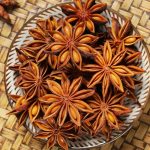
Illustrative image
A rare spice that only a handful of countries can cultivate, Vietnam boasts an abundance of star anise (Illicium verum) with an estimated 40,000 hectares of farmland dedicated to its growth as of 2022. The majority of this farming takes place in the provinces of Lang Son and Cao Bang, yielding an annual production of over 16,000 tons.
Star anise trees begin bearing fruit in their fourth year, but it takes about 16 years to produce two harvests per year, making this spice even more precious. The spring harvest falls between February and March, while the autumn harvest occurs in September and October. Typically, the anise stars are sun-dried post-harvest and exported in their dried form, with only a small fraction distilled into essential oil. According to the World Spice Organization, Vietnam ranks second in star anise production globally, just behind China.
Preliminary statistics from the Vietnam Pepper Association (VPA) indicate that in August, Vietnam exported 1,146 tons of star anise valued at $5.4 million, a 31% decrease from the previous month. Cumulatively, from January to August, Vietnam exported 9,831 tons of star anise, earning $47.3 million. This represents a 1.7% decrease in volume and a 17.8% decrease in value compared to the same period last year.
India remains the largest importer of Vietnamese star anise, purchasing 6,083 tons during this period, reflecting a 6.3% increase compared to the previous year. The United States follows closely with 694 tons, marking an 8.4% increase. Taiwan has surged to the third spot with 301 tons, an impressive surge of 169% compared to the same period in 2023.

Leading exporters of star anise include Prosi Thang Long with 1,805 tons, Nedspice Vietnam with 622 tons, Tuan Minh with 526 tons, and Senspices Vietnam with 378 tons.
India, being the top consumer of cinnamon and star anise globally, is also a significant producer of herbal medicines. Currently, Vietnam dominates the Indian market, supplying over 80% of their cinnamon and star anise imports. With India’s vast population, the market demand for these spices and herbal products is substantial.
When it comes to star anise in Vietnam, Lang Son is renowned as the ‘capital’ of this spice, boasting extensive farmland and an annual economic value exceeding 1,000 billion VND. According to the Lang Son Department of Agriculture and Rural Development, in 2022 alone, the estimated yield was 13,000 tons of dried star anise, generating approximately 1,500 billion VND. The previous year, 2021, saw exports of Lang Son star anise reach $31 million, equivalent to approximately 3,500 tons of dried star anise.
Experts evaluate that Vietnam’s agriculture and processing industries for cinnamon and herbal medicines have entered a sustainable development phase. This involves a shift away from crude products and traditional cultivation methods toward more sophisticated deep-processed products with higher competitive value. Emphasis is also placed on value chain production.
Looking ahead, Vietnam’s cinnamon export sector is anticipated to thrive, bolstering the value of Vietnamese agricultural products and improving the livelihoods of farmers. Continued collaboration between the government and businesses is essential to sustain and build upon these achievements, along with intensified research, development, and market expansion efforts.
















